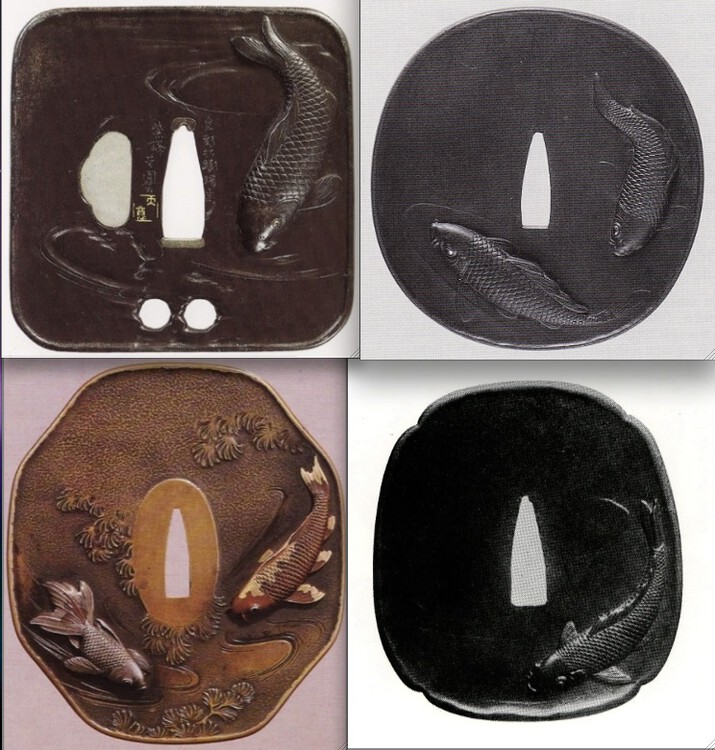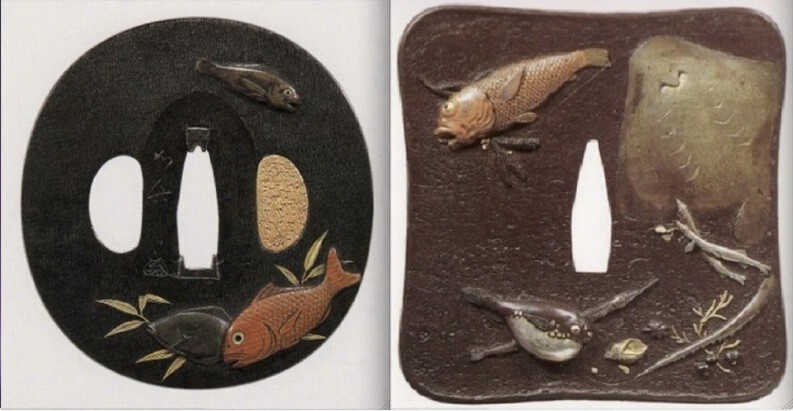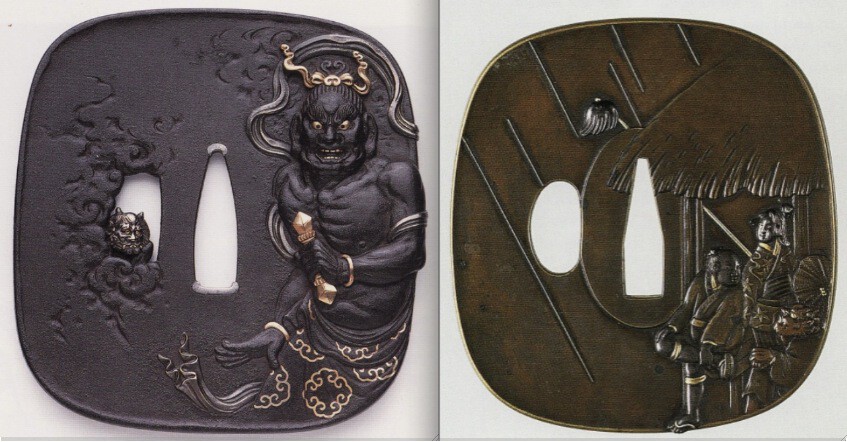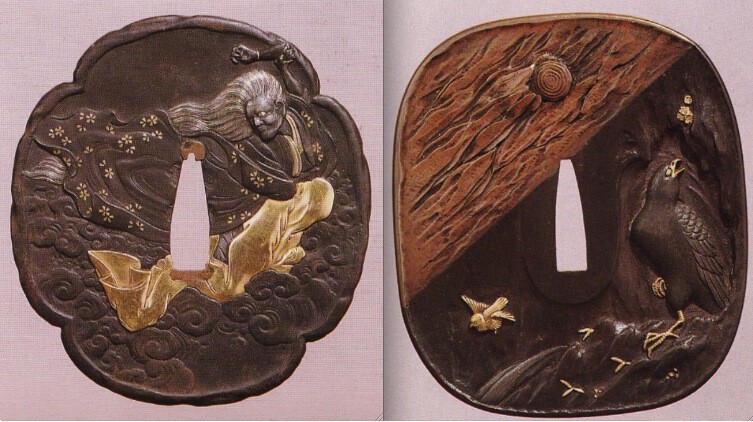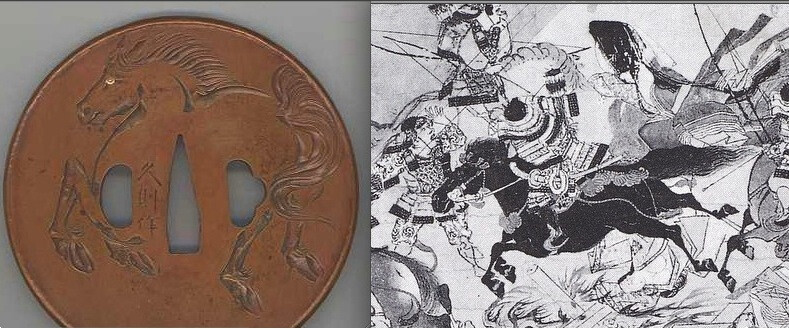-
Posts
768 -
Joined
-
Days Won
1
Content Type
Profiles
Forums
Events
Store
Downloads
Gallery
Everything posted by reinhard
-
Gentlemen, thank you very much for participating. Those of you criticizing me for offering an opinion only are right of course, but like I said: this thread was never meant to be a lecture (for which I'm not competent anyway). I do respect many of your points of view differing from my own, but I won't provide you with pics and examples illustrating your opinions. You must do that yourselves, if you please. Finally I would like to present 4 tsuba depicting Koi, made during second half of 19th c., reflecting some of my theories. top left: made by Shiho HOEN around 1870. The Koi is of big size. The artist didn't feel comfortable with the empty space left on the plate and added some wavy fillings, but they are badly designed, unnecessary, carelessly executed. This tsuba is a half-hearted compromise between Japanese aesthetics and Western expectations. bottom left: signed: TOSHIMASA, later 19th c., 10.4cm vertical diameter. This tsuba is the perfect example for an eye-catcher, trying to get the attention of a lesser educated Japanophile: big size, bright and shiny colors, some elaborated details; but all in all it is the kind of pompous "Kitsch" traditional Japanese aesthetics do not display. top right: described as "NATSUO-school". Meiji-period. The Koi are nicely executed (sorry for the bad pic) and design is pretty well-balanced, although the Koi appear somewhat fat and fleshy, deliberatly trying to fill the frame. I imagine Westerners with a more refined taste enjoying this tsuba. Made for export, but not giving tradition away. bottom right: This is a tsuba by Kano NATSUO (again sorry for the pic). Design is perfectly in accordance with refined principles of Japanese aesthetics. Well-balanced it is, without any unneccessary ballast. Instead of loading the empty space(s) with all kind of stuff, NATSUO trusted in the supreme quality of ground material and finish. Kano NATSUO was designated an artisan of the imperial household. Along with Goto ICHIJO he set the standards for refined Japanese taste during later 19th c. - This particular tsuba is the very opposite of what I'd call a "Hama-mono" although it was made during later 19th century. reinhard
-
Another "Western" feature of many Meiji-period tsuba is a theatrical exaggeration. This is particularly obvious when design was meant to depict motion. In most cases they are displaying a "dead serious" attitude when it comes to "drama and adventure". Earlier approaches to the same topics dealt with the subject with a sense of dignity and understatement. At least they showed some originality and/or a sense of humour. Meiji-period tsuba often have this "Hollywood-esk" quality that makes them look ridiculous. Two examples to illustrate my point of view: Nio-O, traditionally depicted with super-human muscles in order to visualize his divine nature, is reduced to an eye-rolling clown; staring at the viewer frontally, ready to jump out of the frame and looking like a steroid-crazed runner of the 4x100m at Olympic games. - The other tsuba is telling the story of Nitta no Shiro killing a giant boar. It looks like a screen-shot from a silly movie. There is a tsuba by Otsuki MITSUOKI, dating from late Edo-period, depicting the same topic in a much more dignified way, but I could not find it quickly. reinhard
-
BTW, Mr.Trotter, it was "cheap hooker" I said, not "old one". Although I'm not perfectly familiar with the English language, I'm trying to choose my words carefully, even if they sound provoking to your ears. Please do not quote me falsely according to your own interpretation. Thank you. reinhard
-
Here's some more mind-food in order to elaborate Japanese and Western principles of aesthetics as far as tsuba are concerned: I'll start with two tsuba displaying the "fish theme". One of them is a very famous tsuba displaying a "traditional approach". The other one is the tsuba made during Meiji-period you have already seen. Apart from details of craftsmanship, the use of space available on the plate for design is quite different. In order to illustrate this point of view, I'll give you another example, comparing the "hawk on a rock"-theme on a tsuba made by Ishiguro MASAYOSHI to an "Ishiguro-style" tsuba dating from Meiji-period. I'm aware of the fact that most samurai could not afford buying from top-level fitting-makers, but that's not what it is about. reinhard
-
This thread is not supposed to arrive at any final conclusion. It is about collecting ideas and infos. First of all, my examples posted here are from Western collections. It is quite difficult to find tsuba like these in Japan (or Japanese books) that have not left the country in the meantime. You will never find them in the legacies of Daimyo families. In Japan their prestige was obviously quite low at the time of their manufacture. Why? Some of them were quite skillfully executed, but educated Japanese didn't like them. Some of the older schools and masters made spectacular tsuba as well. What are the differences? After a while you get a feel for them, but putting this sentiment into words and creating criteria is not easy. That's why I started this thread. Here are a few ideas to consider and to discuss (this is not supposed to be a lecture): - traditional Japanese design "knows when to stop". There should be a balance between empty spaces and the one(s) occupied by actual design. Some Meiji-period tsuba are crowded and (over-)loaded with too many things. The tsuba with fish and ray is a good example. - the motto "the bigger the better" might suit McDonald's and simple minds, but is contradictory to Japanese aesthetics. This goes for the size of plates as well as for the space occupied by design. - colors should always be in harmony as well as the finish of the ground material. Japanese favoured ones and disliked others, but most of all: they should go on well together. Many Meiji-period tsuba are lacking this quality. Flashy "bling bling stuff" and mismatching colors are as far from the "real thing" as they can get. Well-made tsuba are glowing, not shining. - understatement: hard to believe, but this was a real quality before Meiji-period. Even spectacular works by Ishiguro-school artists, Mito KinKo and others are not displaying their true qualities at first sight. Many Meiji-period tsuba however are pretenders at first sight. Trying to capture the eye, but disappointing at second sight. BTW I had to go quite deep into my library to find (confirmed) tsuba of Meiji-period illustrating my point of view. Please stick to these examples unless you are sure of what you are posting. Otherwise confusion is sure to come. Thank you. reinhard
-
Poor Tim accidentally got in the line of fire with his "HISANORI"-tsuba. The topic of Hama-mono and foreign influence in Japan during later 19th c. has not been circumstantially discussed yet on NMB. The topic has been taken somewhat controversial here and it has been neglected by scholars in East and West for a long time. It would be nice to start a talk about works made for export and their importance for understanding Japanese aesthetics and Western preferences. When my interest in Japanese arts started some 20 years ago, I was fascinated by mere skills at first, attracted by designs I felt familiar with. - By now I'm appreciating works of ToSho artists as well as works of Kano NATSUO. They are all in line with Japanese principles of aesthetics, sometimes stretching them, but never giving them away. On the other hand there are works by (technically) skilled artists just calling for (Western) money, renouncing roots and dignity. Some of their works look like "old Japan goes Walt Disney". Over-sized plates, overloaded with flamboyant eye-catchers; rolling eyes, wide open, watching frontally at the viewer; shiny colors etc. The Japanese anticipated very quickly. Many of these works remind me of a cheap hooker abandoned by all dignity and any sense of humour. What do you think? Attached are some examples obviously made for export. Some of them with a false mei. reinhard
-
Dear Ford, The recently presented "sho" tsuba is illustrating my point very well, don't you think? I'm looking forward to argue with you about principles of Japanese aesthetics (no sarcasm). See you on the road. best regards reinhard
-
You may see it that way, Ford. This might be the trouble with any debate about sense of aesthetics. To me design and execution of this particular tsuba look plain, uninspired, boring. It is also a pompous and pretty spectacular tsuba at first sight, quite skillfully executed, just the way most Westerners like(d) it. We could go on discussing this endlessly, but I'd prefer not to. If it starts with a 13th century picture scroll where will it end? Links to Japan's culture and arts of a thousand years, just to prove me wrong? I won't play the game on the basis of this particular tsuba. Obviously it is supposed to be the only remaining example of a forgotten master. Your quote posted here sounds rather disrespectful to me, like another one mentioning the advantages of knowing about Japanese paintings, implying I don't know anything about it. Well, you're wrong. See, I really acknowledge your technical skills, but apart from that I'm not one of Ford Hallam's disciples, bowing their heads to the ground as soon as they hear their master's name. I don't expect you to agree with me in any particular question, but I presume a minimal respect given. I agree to disagree one more time. Let's leave it that. reinhard
-
Show me any tsuba, as pompous and theatrical as this one, predating Meiji-period and this discussion will eventually start to make sense. A "HISANORI"-mei on it would be nice to see as well, adding at least some credibility to former statements. Go on, convince me. I wonder if this talk is still about this particular tsuba or just about establishing profiles? reinhard
-
Ford, Actually there are remarkable differences and they are making the difference between Japanese aesthetics and Western-orientated design. Hardly any artist working for export during second half of 19th century was able to bridge these poles succesfully without betraying one principle or the other. If you don't mind I would like to stick to Tsuba and their very particular demands. Widening the topic to (Western) images and (Japanese) picture scrolls won't get us anywhere. Show me any (confirmed) tsuba by untraceable (sic!) Hisanori or any other Tsubako with a similar design and workmanship predateing late Bakumatsu or Meiji-period and I will bow. This tsuba fits all criteria of late work made for export. Size, design, execution, a dubious, untraceable mei etc. It's quite obvious, don't you think? regards reinhard
-
Well, I do. Even more so when looking at the reverse. Design looks rather "modern" and there is hardly anything I can connote with works predating Bakumatsu or Meiji-period. The size of the plate is somewhat oversized which is a typical feature of Hama-Mono. This is not necessarily a bad thing, for some tsuba made for export were crafted by highly skillful artists. Lacking raw materials or the like, Japan depended mainly on traditional craftsmanship when it was entering global markets during later 19th century. When the days of the samurai ended, some of the artists and craftsmen found a new market, but the new customers were different. Instead of samurai and local merchants, Westerners had to buy their products. Guess what happened. This particular tsuba fits in there perfectly to me. Skillfully executed it is, but quite far from any traditional sense of aesthetics. reinhard
-

Stepping away from Moderation
reinhard replied to Ted Tenold's topic in General Nihonto Related Discussion
Fare thee well, Ted. It was a pleasure to meet you at Token Ichi two years ago and I hope we will meet again on the road. Thanks. reinhard -
I agree with Ted. Western expectations (size, design, proportions, colour etc.) combined with traditional Japanese skills and craftsmanship automatically lead to Hama-Mono: things made for export during Meiji-period. Everything about this tsuba is pointing this way. It looks like a well executed piece of work, but somehow far from Japanese sense of aesthetics. Just one question: What are the measurements of this tsuba (horizontal and vertical diameter)? reinhard
-
Forget about Taikans and hi-res pics. No serious collector will buy a KIYOMARO blade before seing it in his own hands. I've seen about a dozen of his best blades in hand, including the one he made for Kubota Sugane, presently Juyo Bijutsuhin. You are losing yourselves in virtual, meaningless discussions. reinhard
-
Hi George, Basically I agree with your statement, but since NMB and sword trade are almost impossible to separate, I'm trying to differ between professional dealers guided by commercial interests only and amateurs. I'm not willing to do homework for the former but am ready to help the latter. The amateur can be an enthusiastic beginner as well as an overcharged heir knowing nothing about NihonTo at all. He has a right of getting a reasonable answer as well. I will not provide him with answers unasked, but I don't care either if my post on NMB gets to him by other ways. Personally I'm favouring more transparency of personalities and their intentions on NMB and a separation of interests here, but this is not my cup of tea. Brian and his team have to decide. Since informations gained from NMB are dispersing into business through all sorts of channels, inside and outside of NMB have become very difficult to discern. In the end it seems only natural to me that everybody is trying to get advantage from this board. Why protect some ("quiet, knowledgeable bidder") and leave the others? regards reinhard
-
What exactly do you think is NMB made for? reinhard
-
Bunnies in a whirl-pool under the moon of love. Check short treatises by famous philosopher Mr.Hugh Hefner. reinhard
-
The "SA" mei on this blade cannot be one of famous O-SA. Its writing style is completely different from SA's and placed on the sashi-omote side of a katana is excluding it from any further speculations. However, there was a sword-making centre in Chikugo province during Muromachi period, where Kaji used this famous name as a trademark. He was supposed to be their predecessor. A similar phenomenon can be seen on swords made in Seki during Muromachi period BTW. Kaji there used the trademark "KANEUJI" for a quite a while. Therefore this mei is not necessarily a gimei. Further research will be necessary. reinhard
-
My previous post was meant to be ironical. It failed. But seriously though. A blade with little nioi-giri actually can pass shinsa. There is a well-known katana by shodai MURAMASA with obvious nioi-giri f.e.. A Japanese friend of mine told me that this "flaw" might be considered a feature of this particular style, for the earlest MURAMASA blades tend to have an extremely thin and constricted nioi-guchi in places. However, nioi-giri is a flaw that should be avoided, but if the blade is very good otherwise, it will be tolerated. Cosmetic repair of lost nioi-guchi exists. Adding a row of very small, super fine scratches, parallel to each other, perpendicular to the Ha and placed along the missing nioi-guchi line, will create a stunning effect when the blade is held pointing towards light. I've seen a missing boshi replaced that way and the fraud was pretty hard to detect. A shinsa-team, however, will not be fooled by cosmetics like these. reinhard
-
That's it! Find a polisher to correct substantial faults, but don't forget to ask him for how long the make-up will last. Interesting first-draft that is. It shouldn't be your last though. reinhard
-

NAOTANE AND HIS MEI AND KAO
reinhard replied to Eric H's topic in General Nihonto Related Discussion
Hello Eric, Thank you very much for this most entertaining and educative riddle. I have a question though. According to Tanobe-sensei the signatures D left and both from table E are displaying one or several features of Kajihei's false mei of NAOTANE (his teacher). Are these blades safely attributed to NAOTANE? best regards reinhard -
Steve, I'm sorry for the lack of clarity in my post. What I meant was: Reasoning and argumentation need a foundation. There must be impartial parameters to start with. Most of these parameters have been established a long time ago as far as the "classic" Japanese arts are concerned. Asking for individual choice to build reasoning upon is what I meant by "cry for democracy". I have to admit the term was not well chosen, but reasoning without or beyond established parameters is redundant, no matter how strong the chain of logic may be. Unlike modern art, the arts of the sword leave us with hardly any room for setting our own parameters. What I understood from your posts so far is a strong desire to establish your opinion/personal preference by "strength of reasoning", but I wonder what the underlying parameters are? You consider "third-class Momoyama iron" (whatever that means) superior to "the vast majority of Edo Kinko" (also a quite murky expression, don't you think?). It's hard to believe, you are considering these matters so simple. Is it just sublime art from vital Momoyama period vs plain craftsmanship from degenerate Edo period? And what is your judgement based on? Over-simplification makes it hard to discuss. I'm well aware of the fact, that many, if not most Japanese people have little or no affinity to, nor knowledge of their cultural heritage. Therefore I'm not talking of any mysterious, innate ability, given to Japanese people to understand the arts of the sword, but of those Japanese, who are interested in the matter and were encouraged to go this way from early age on (like a good friend of mine, who grew up as son of a well-known collector and sword-dealer). They have a great advantage compared to Westerners, who are discovering NihonTo at a comparatively late moment in their life, handicaped by their "cultural imprint" too. Once in a while I notice for myself that I have to get rid again of some "Western attitudes" towards Japanese arts. It's always a small step forward, although there are gaps I will probably never be able to fill. I understand you are getting tired of this thread. I hope you don't mind. best regards reinhard
-
Relax John, I'm talking about the perception of art and craftsmanship, not politics. reinhard
-
You are calling for objectivity that cannot exist according to your previous posts. Theoretically non-Japanese persons can adapt to Japanese criteria of quality, but they have a long way to go. Almost all of them trying never reach true mastery. Their Western point of view is obsolete anyway. Crying for democracy is premature and ignorant in front of an old and most sophisticated culture. reinhard
-


